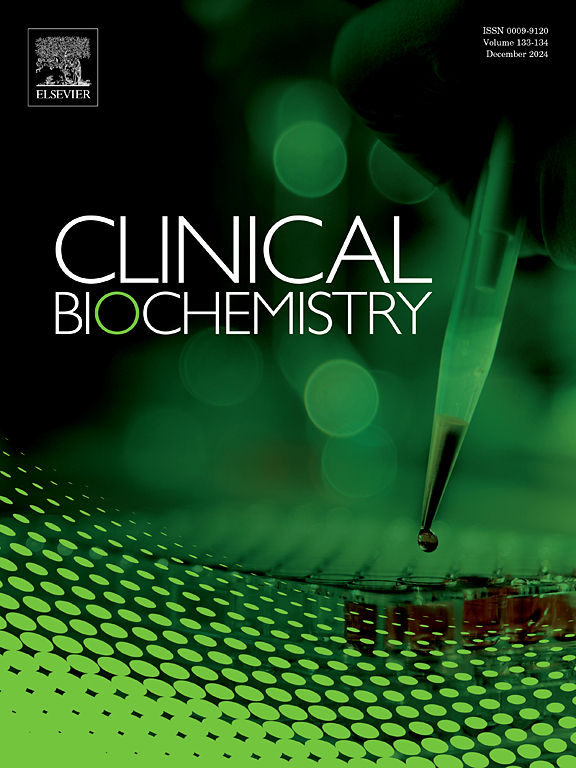使用西门子高灵敏度心肌肌钙蛋白I测定加速心肌梗死的诊断途径。
IF 2.5
3区 医学
Q2 MEDICAL LABORATORY TECHNOLOGY
引用次数: 0
摘要
背景:很少有研究使用西门子ADVIA Centaur hs-cTnI检测方法全面检查早期患者心肌梗死(MI)的高灵敏度心肌肌钙蛋白I (hs-cTnI)诊断途径。方法:我们在急诊科进行了一项前瞻性多中心队列研究,涉及414例在症状出现6 小时内疑似心肌梗死的患者。我们评估了三种基于hs- ctni的通路(High-STEACS, ESC 0/1-h, 0/2-h);以及包含病史和体格检查结果的四种途径(ADAPT, EDACS, HEART, GRACE)。我们评估了阴性预测值(NPV)和敏感性作为安全措施,以及排除百分比作为30 天内1型心肌梗死或心源性死亡主要结局的效率措施。结果:中位年龄为72 岁(四分位数范围为58 ~ 82),80岁以上患者占30.4% %(126/414)。女性占44.2% %(183/414),胸痛发生率为87.7 %(363/414),主要结局发生率为9.2% %(38/414)。高steacs途径排除了62.0 %的患者,没有遗漏一例心肌梗死。ESC 0/1-h和0/2-h途径显示高NPV和敏感性;然而,他们排除的患者较少(分别为35.9% %和45.2% %)。ADAPT、EDACS和HEART途径显示出较高的NPV和敏感性,但排除的患者较少(15-27 %)。GRACE途径遗漏了2例具有主要临床结局的病例。在80岁以上无心肌梗死的患者中,hs-cTnI初始浓度为 ≥ 3 ng/L的占99.1 %, ≥ 5 ng/L的占84.1 %。结论:在以hs- ctni为基础的途径中,High-STEACS途径是最有效的,同时在早期患者中保持了良好的安全性。本文章由计算机程序翻译,如有差异,请以英文原文为准。
Accelerated diagnostic pathways for myocardial infarction using a Siemens High-Sensitivity cardiac troponin I assay
Background
Few studies have comprehensively examined high-sensitivity cardiac troponin I (hs-cTnI) based diagnostic pathways for myocardial infarction (MI) in early presenters using a Siemens ADVIA Centaur hs-cTnI assay.
Methods
We conducted a prospective multicenter cohort study in Emergency Departments involving 414 patients suspected of MI within 6 h of symptom onset. We evaluated three hs-cTnI-based pathways (High-STEACS, ESC 0/1-h, 0/2-h); and four pathways incorporating medical history and physical findings (ADAPT, EDACS, HEART, GRACE). We evaluated negative predictive value (NPV) and sensitivity as safety measures, and percentage ruled out as an efficiency measure for a primary outcome of type 1 myocardial infarction or cardiac death within 30 days.
Results
Median age was 72 years (interquartile range 58–82), and 30.4 % (126/414) of patients were over 80. Females comprised 44.2 % (183/414) of patients, 87.7 % (363/414) had chest pain, and the primary outcome occurred in 9.2 % (38/414). The High-STEACS pathway ruled out 62.0 % of patients without missing a case of an MI. The ESC 0/1-h and 0/2-h pathways showed high NPV and sensitivities; however, they ruled out fewer patients (35.9 % and 45.2 %, respectively). The ADAPT, EDACS, and HEART pathways demonstrated high NPV and sensitivities but ruled out fewer patients (15–27 %). The GRACE pathway missed 2 cases with primary clinical outcomes. Among patients over 80 without MI, initial hs-cTnI concentration was ≥ 3 ng/L in 99.1 % and ≥ 5 ng/L in 84.1 %.
Conclusions
The High-STEACS pathway was the most efficient among the hs-cTnI-based pathways while maintaining excellent safety performance in early presenters.
求助全文
通过发布文献求助,成功后即可免费获取论文全文。
去求助
来源期刊

Clinical biochemistry
医学-医学实验技术
CiteScore
5.10
自引率
0.00%
发文量
151
审稿时长
25 days
期刊介绍:
Clinical Biochemistry publishes articles relating to clinical chemistry, molecular biology and genetics, therapeutic drug monitoring and toxicology, laboratory immunology and laboratory medicine in general, with the focus on analytical and clinical investigation of laboratory tests in humans used for diagnosis, prognosis, treatment and therapy, and monitoring of disease.
 求助内容:
求助内容: 应助结果提醒方式:
应助结果提醒方式:


